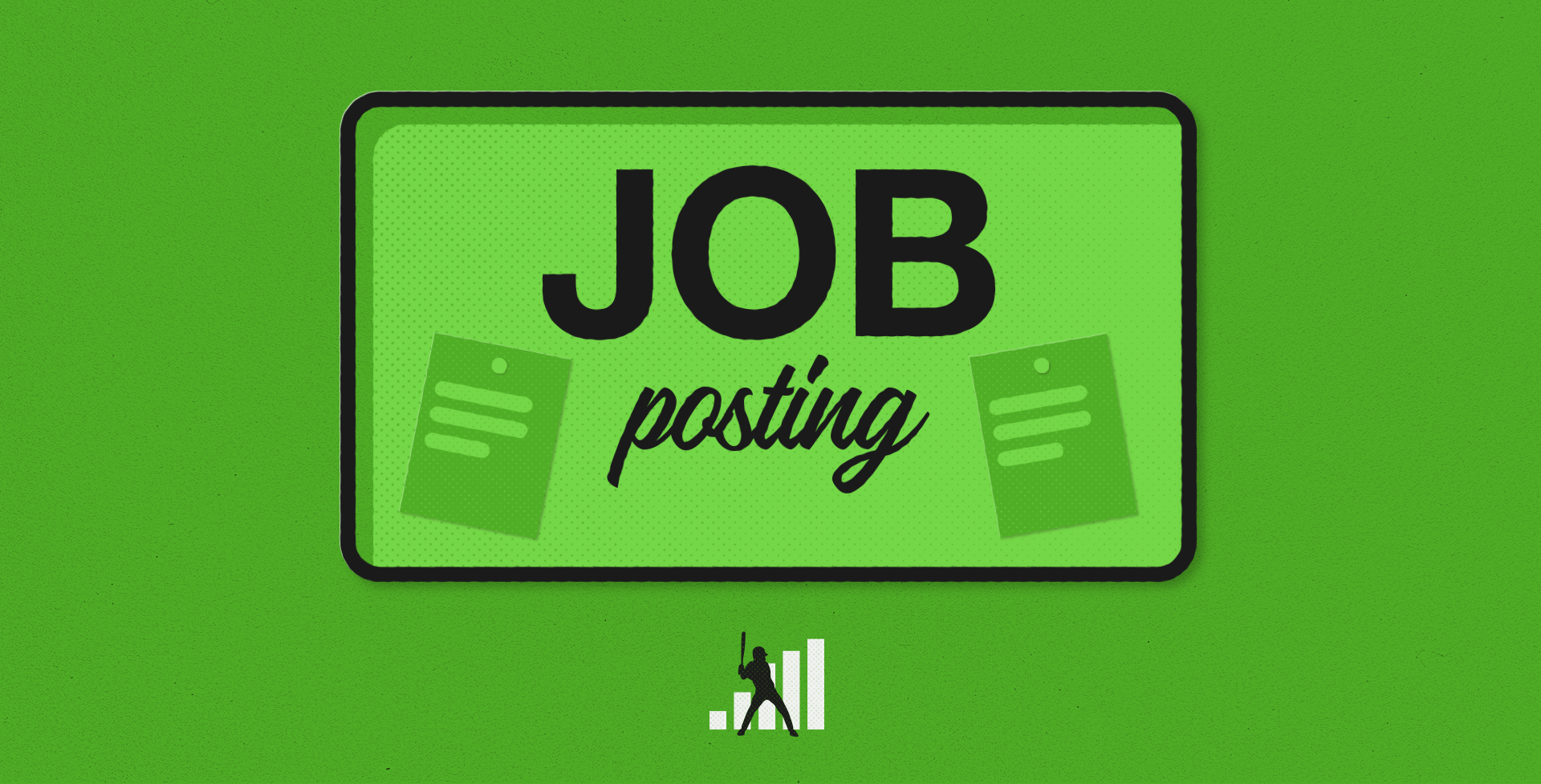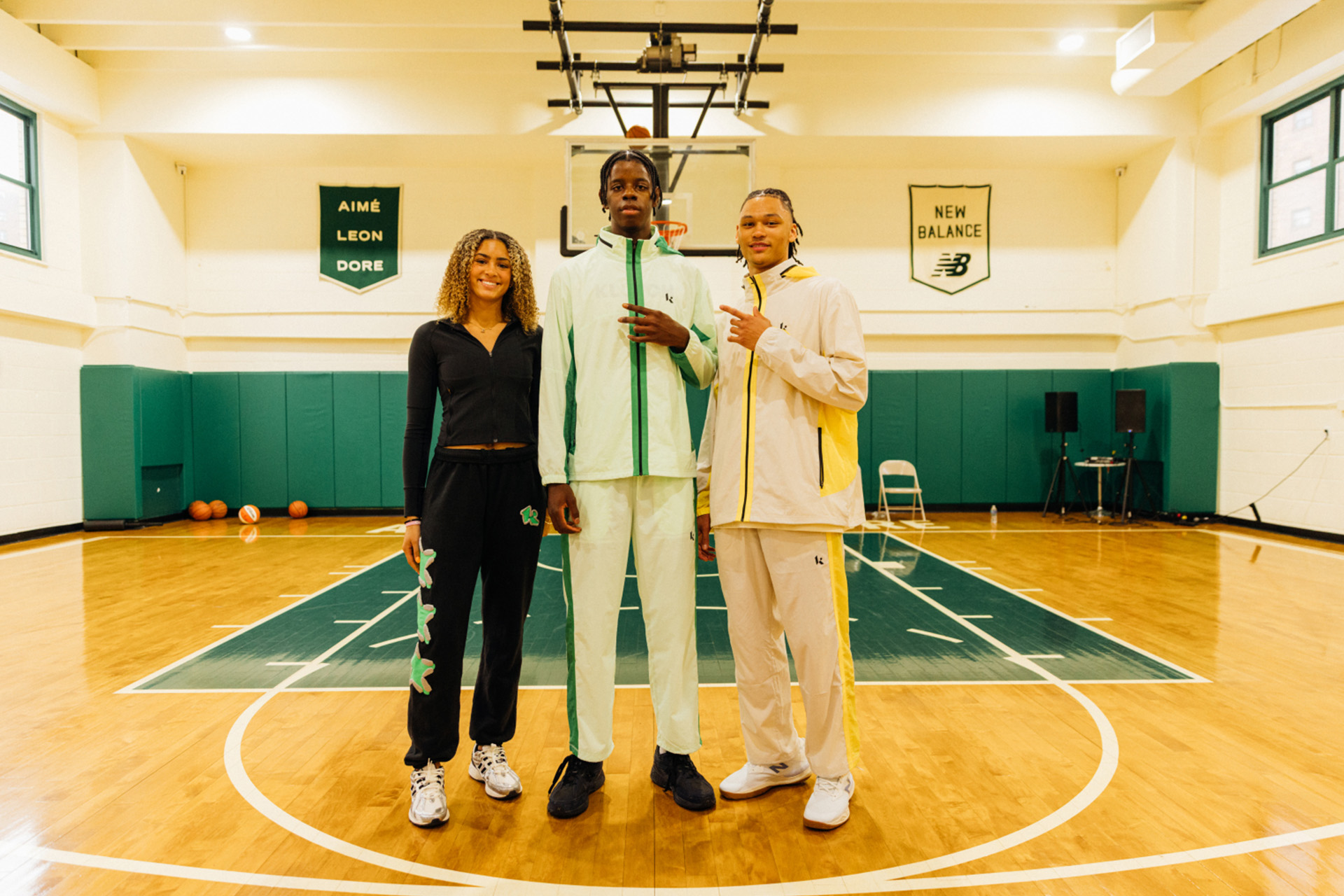[ad_1]
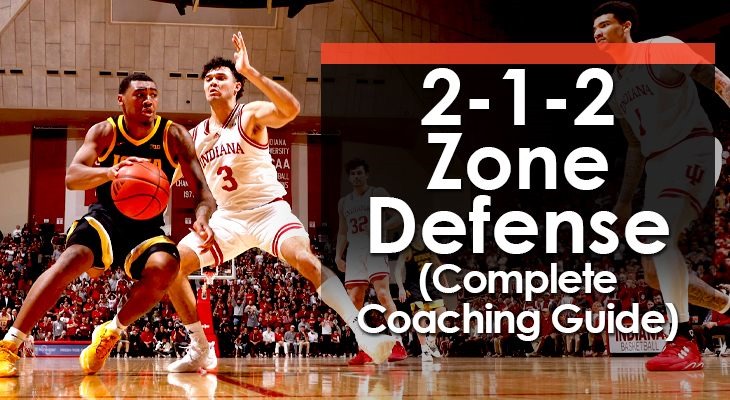
The 2-3 zone defense is probably the most popular zone defense in basketball.
But there are some definite weaknesses in the 2-3 zone – particularly in how it covers the high post and how teams rebound out of it.
That’s where the 2-1-2 zone defense comes in.
With some very slight variations in where players are placed to begin with, a 2-1-2 zone can help to minimize some of these weaknesses.
You just have to have the right kind of center to plug into the middle to make it work.
Below is our full 2-1-2 zone coaching guide.
But first…
The Differences Between a 2-1-2 Zone and 2-3 Zone
The primary difference between a 2-1-2 zone defense and a 2-3 zone defense is the position of the center.
In a 2-1-2, the center is up at the high post to contest any passes there right from the beginning of each possession.
While in a 2-3, the center typically plays near the rim to clog the lane and may close out to the high post on a catch, but not before that.
Because of the different coverage responsibilities, it also requires a different type of player for each defense.
A taller defensive player who typically isn’t very mobile is a great fit for a 2-3 zone…
But for the 2-1-2 zone, a long and athletic big who is able to move and block shots is the perfect type of player to put in the middle.
Advantages of the 2-1-2 Zone Defense
1. High Post Coverage
Having an agile center that can move and block shots play up at the free throw area in the 2-1-2 zone makes the high post pass a lot less enticing for the offense.
Even if the offense does take the chance and throw the ball there, there will be very little space for the offensive player to operate and there’s a good chance they will get their shot blocked.
2. Defensive Rebounding
Another advantage of starting the center near the free-throw line area is that it makes finding a player to box out a lot easier.
In a normal 2-3 defense, the center is closer to the basket, meaning it requires a lot of discipline to find and meet an offensive player who gets a running start to crash the boards.
In the 2-1-2 however, the center is already located in the high post and will be able to make immediate contact and prevent the offensive player from advancing near the rim for a rebound.
3. Quicker Help on Penetration
Because the center is positioned higher in the 2-1-2, help is able to stop the ball sooner on drives and keep the offense from getting to the rim.
Due to the center roaming around the paint and following the ball, they will always be in line with the ball and the basket and be ready to halt any advancing dribbles before they get too far.
Weaknesses of the 2-1-2 Zone Defense
1. Covering Multiple Outside Shooters
While the 2-1-2 may do a good job limiting high post attacks, it will struggle to contest outside shots if there are multiple shooters on the perimeter.
It is possible for the offense to overload a side and force the defense to help and bump their teammates, which can create open shots around the 3-point line.
2. Potential for Lobs
This won’t hurt all teams, but teams capable of throwing lobs passes can hurt a 2-1-2.
Since the center is stationed around the free-throw line to take away the high post, it does typically leave smaller players nearer the basket.
Therefore if an offense has a good passer and some players who can fly, they can throw the ball over the top of the smaller back players for some potential dunks.
3. Takes Constant Communication
Teams must be very good at communicating to run any zone defense, and the 2-1-2 is no exception.
Defenders must communicate cutters and offensive players who station themselves behind the defense so the offense isn’t able to get any cheap baskets.
2-1-2 Zone Defense Rules
1. Hands Up – For this defense to be effective, all players must keep their hands up throughout entire defensive possessions. This will shrink gaps in the defense and prevent the offense from being able to throw quick, direct passes that will put the defense at a disadvantage.
2. Move on the Pass and Arrive on the Catch – All of the defenders need to move as the ball is in the air to prevent the offense from getting any open looks. The goal of the defenders should be to beat the ball to where it’s going. The quicker your team can close out on the ball, the better your defense will be.
3. Communicate – All good defenses are loud with constant talking. This is especially true for zones since they’re guarding areas where the offensive players are constantly changing. Making sure teammates know where cutters are going, especially when they are coming from behind them, is important for the 2-1-2 zone to be effective.
4. 1-on-1 in the Paint – What makes the 2-1-2 unique and also effective is that the center is long, athletic, and able to control the paint. So if the ball goes into the post, either high or low, the center is in charge of guarding it 1 on 1. The top players should fan out and identify shooters to be able to take a kickout pass. The wings should play inside-out, heading to the blocks to take away a high-low pass but then widening out to find shooters.
Individual Roles and Responsibilities
Tops
The two top players in the 2-1-2 defense generally take the ball whenever it is at the free throw line extended or above, including the top of the key.
If the defense is really good, the 2 up top can “guard” the top without actually completely committing to that spot by stunting at the ball on a catch.
These players are also responsible for making it difficult to get the ball into the high post.
Wings
The 2 lower players are primarily responsible for anything below the free throw line extended and also the weakside post area to prevent a lob into the paint.
In addition, these players are responsible for taking passes to the wing for a short period until they are bumped off by one of the top players.
Middle
The player in the middle of the 2-1-2 zone defense, typically a center, is who makes or breaks this defense. This player is responsible for basically guarding the paint.
As the ball is higher on the floor, the middle player focuses on the high post.
As the ball gets lower on the court, this player drops more to the block area to take away any low post player if one is present.
Since this player needs to be a long, athletic, shot blocker for this defense to be successful, if the ball ever gets entered into the paint, the middle player is responsible for playing it 1-on-1.
This player also provides help on any dribble penetration toward the basket.
How to Run the 2-1-2 Zone Defense
Ball on Top
As the ball nears the 3-point line, it is the responsibility of the top 2 players to pick up the ball without completely committing to it so they remain closer to the wings.
The point should feel guarded up top without seeing anyone directly at the top of the key.
The top players do this by stunting and motioning toward the ball.
The wings should move slightly out and up to be ready to take any wing pass for a brief time until a top player is there to bump them down. If there is a player on the block, they may need to cheat slightly toward them to prevent an easy basket.
The position of the middle player depends on the alignment of the offense.
If there is a high post player, then they are positioned behind them. If it’s a really strong offensive player who you don’t want to catch the ball, then you can have that player play three-quarters defense to keep the ball out of there.
If there is no high post player, then the middle player can drop back to the middle of the paint. But they have to be aware if anyone flashes to that area so they can adjust their position.
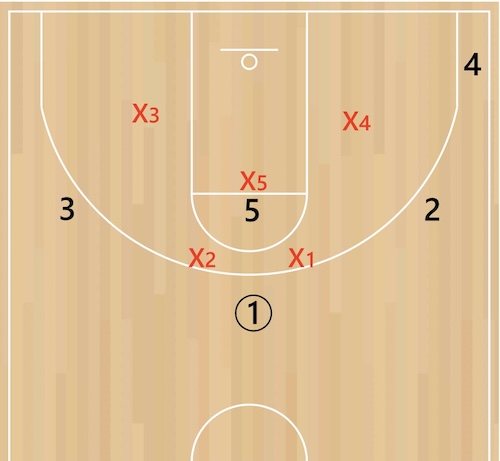
Ball on Wing
On the pass to the wing, a wing defender should at least stunt at it if not completely take the ball for a brief time to give a top defender time to get there and bump them off.
The ball-side wing that gets bumped off should slide down toward the baseline but stay wide enough to close out quickly on the corner if there is a shooter there.
The weak top player should drop to near the free-throw line to take away the high post pass as much as possible. Depending on how good the high post player is, you can have them full front or just put a hand near the passing lane.
This movement allows the middle player to drop closer to the basket. If there is a player at the block, then the middle defender will completely drop down to front the block. If not, then they can remain near the mid-post area.
The weak wing goes to help position near the rim to watch for any lobs. This player also needs to be ready to take any skip pass to the opposite side of the floor.
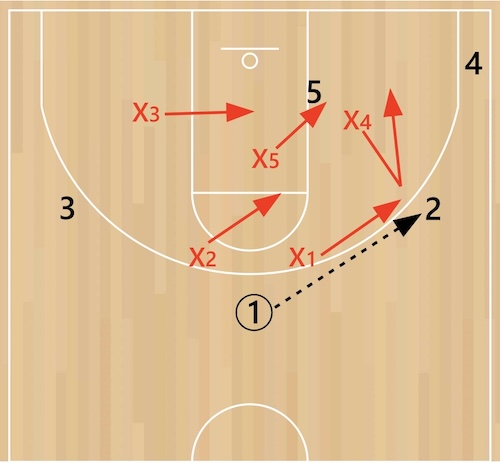
Ball in Corner
On the pass to the corner, the wing on that side closes out and takes away a 3-point shot. The wing also needs to be positioned so the offense is not able to drive baseline.
The ball-side top player drops back to the elbow area to take away any high post passes there.
The middle player remains fronting the block area to prevent any pass into the paint. If there is no low post player, they should still be near the block to be ready to help on any drive.
The weakside top player now drops to help in the middle of the paint. This player is also now ready for any skip passes to the other side of the floor.
The weakside wing stays in help in the paint to defend any lob that the offense could throw into the paint.
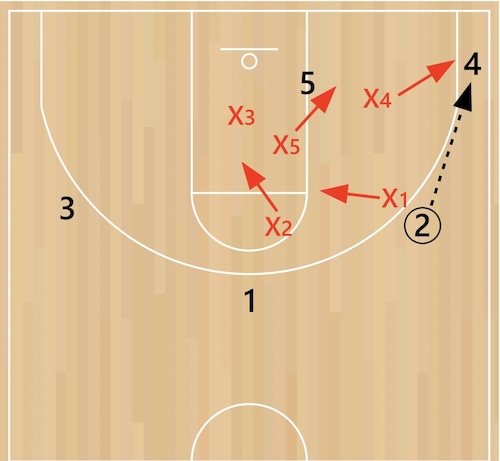
Ball to High Post
On a high post pass, the middle player should take the ball and guard it 1-on-1 like it is man-to-man defense.
The top players should NOT turn and converge on the ball. This leads to an easy kickout pass and open 3-point shot. So what they SHOULD do is find shooters and move toward them to prevent any open outside shots.
The wings should initially get to the blocks to take away any high-low pass for layups. If no offensive players are there, then they can widen out to take shooters on their side of the floor.
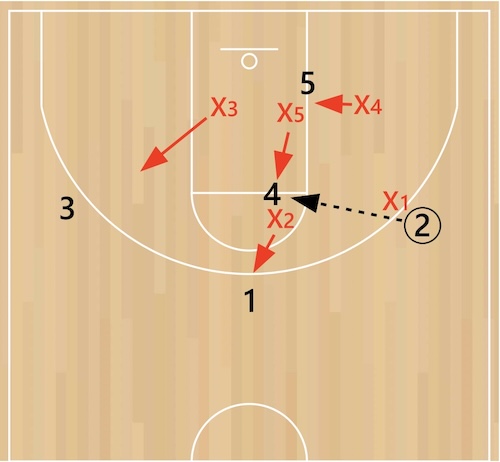
Ball to Short Corner
On a pass to the short corner, the ball-side wing and middle defender will trap it. The middle player should initiate the trap and keep the offense from going baseline while the wing completes the trap from behind.
The weakside wing has the crucial job of getting to the middle of the paint and taking away any potential dives to the basket so the offense doesn’t get an easy layup.
The top players can be more aggressive now that the ball is trapped. So the one on the ball side can cheat out near the wing to take away an easy pass back out. And the weakside top can play centerfield and try to pick off any skip pass.
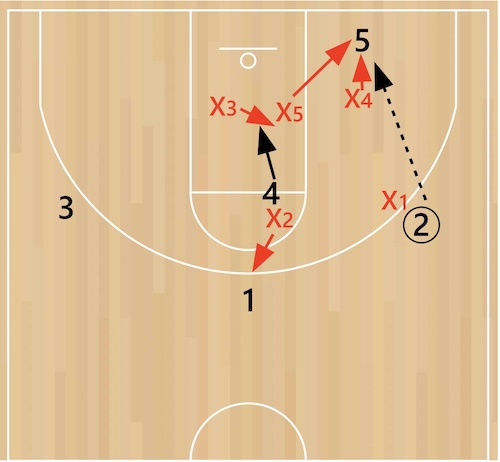
Reversal Pass
As the offense reverses the ball around the perimeter, it is essential that the closeout at the top of the key is correct or the offense will be able to swing the ball quickly for an open shot on the opposite side of the floor.
When the ball gets passed back to the top of the key, the weakside top must widen the closeout to get on the far side of the offensive player up top. This will allow the defender to get in the passing lane of the next pass and slow down their ball movement.
The remaining players get back to their same spots as when the ball was at the top of the key before. However, the weakside wing needs to widen out some so that they are ready to take the wing until they get bumped off to prevent a quick extra pass for an open 3-pointer.
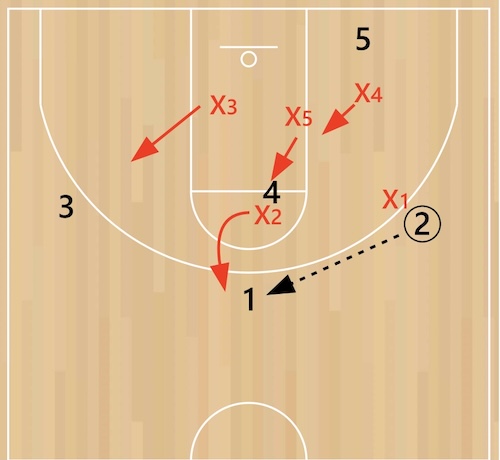
Skip Passes
Skip passes will likely occur often against the 2-1-2 zone defense as that is a common strategy to move the ball and create open shots against zones.
Who covers the skip pass will depend on where the pass comes from.
If the skip pass originates from the wing, then the weakside wing will have to take the ball until being bumped off. That is because the weakside top player will be protecting the high post and won’t have as clear of a path to get to the other wing quickly.
If the skip pass is thrown from a corner, the opposite top player should take it. The reason for that is because the weakside wing has to stay put in the lane to protect against lobs and the top has a much clearer path to the skip pass from the middle of the paint.
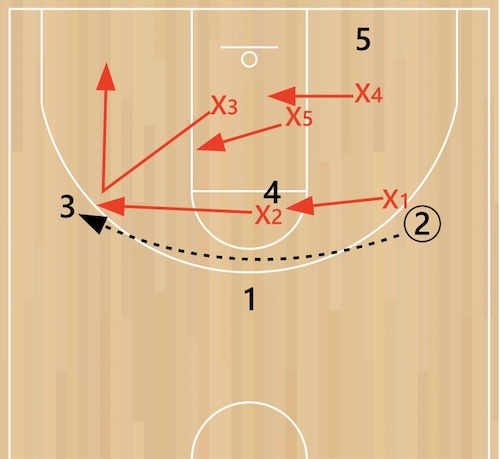
Dribble Penetration
The top and wing players will get beat off the dribble at times in the 2-1-2 zone defense. The good news is that the help on a drive should always be the same and lead to very few mistakes.
Wherever the drive occurs, the middle player should be in a position to get the ball stopped before it gets to the paint. This allows the other players to focus on closing out on outside shooters instead of getting beat on a drive and kick.
The other important fact to remember with dribble penetration is that the wings must make sure to close out so that they force the ball back to the middle and not give up the baseline.
Variation of the 2-1-2 Zone Defense
A 2-1-2 zone variation that puts more pressure on the ball is the “Buzz Defense.”
This form of the 2-1-2 has a very similar setup, but with some slight changes that allow the defense to create more turnovers.
In the Buzz, the top players pick up the ball around the volleyball line.
They both stunt at the point guard with their inside hands and feet while remaining in the passing lanes to force a high, slow entry pass to the wing.
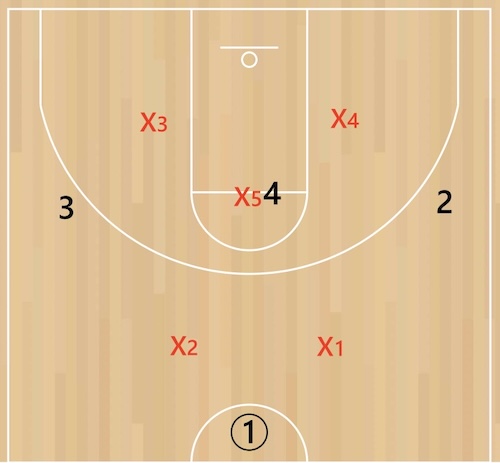
The middle player has a very simple and straightforward task every defensive possession.
They must stay 15 feet away from the rim in line with the ball and the basket at all times.
This positioning allows the rest of the players to know a direct line pass or drive cannot be made to the basket because that player is always there.
The wing positions start slightly outside the blocks and work to prevent lobs while also communicating to their teammates where cutters are going since they are along the back line. They are also active in taking wing passes until they are bumped off.
After that initial pass, the defense is very similar to a normal 2-1-2 zone defense except for one main thing: the outside 4 players play in passing lanes and work hard to funnel the ball toward the middle defender.
This placement of the tops and wings prevents quick passing and often disrupts an offense’s timing and rhythm.
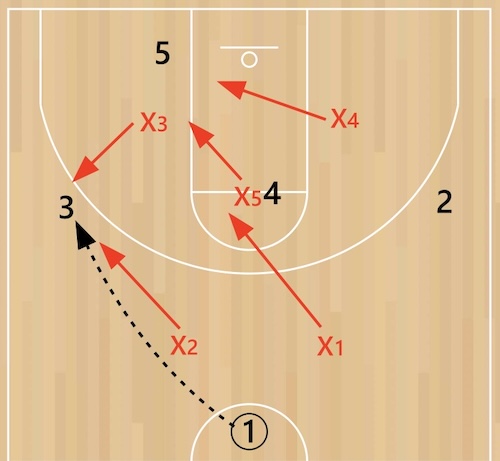
Who Should Use the 2-1-2 Zone Defense?
As has been stated many times, for this defense to work, you really need a long, athletic player who can guard and block shots in the paint.
Of all of those characteristics, the most important one is the athleticism part.
If you’re going to ask a player to be able to guard from the free throw line down to the rim, you need someone who can move and jump well.
Here’s the other thing to keep in mind about playing a 2-1-2 zone defense:
You should absolutely NOT play it if you are coaching youth basketball.
Yes, you would definitely cause offenses a lot of trouble and probably prevent them from scoring many points.
But the goal for youth basketball should be player development for the future, and to do that you should have your players focus on man defense and its principles.
Conclusion
The 2-1-2 zone defense can be a great defense if you have the right player to put in the middle.
A long athlete can shut things down in the paint and allow the other four players to focus on the outside and prevent open 3-point shots, which is oftentimes the downfall of zones.
And with a couple of minor modifications, you can even make the 2-1-2 zone into a defense that pressures the offense into multiple turnovers by positioning defenders in the passing lanes.
If that sounds like how you want to play, and you have the right type of player to put in the middle, then the 2-1-2 zone defense might just be for you.
[ad_2]
Source link

